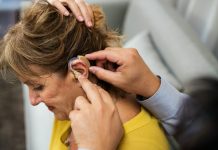
Do you have questions about treatment of age-related macular degeneration, otherwise known as dry AMD? Anjali Rajesh Shah, MD, ophthalmologist, an at Michigan Medicine, has answers.
Here’s six things you and your family should know about treating the condition.
- There’s two new medications available for dry AMD
Rajesh Shah: There are two new medications: one, pegcetacoplan; Synfovre, was just approved by the Food and Drug Adminstration, and the other, avacincaptad; Zimura, will likely receive its FDA approval in August.
Both have very similar effectiveness profiles and side effects.
These medications have been shown to slow the progression of a very particular severe form of dry AMD called geographic atrophy, though they are not approved for other types of dry AMD.
It’s important to note that the drugs do not reverse or stop progression, but they may delay further vision loss. While a simplification, we estimate that the drugs slow the rate of progression by 1-3 months each year.
In other words, if the disease was going to progress to a certain stage of severity in 24 months, it would take 27-30 months when you’re on the drug based on the results of clinical trials
- And there’s a very specific way you take them
Rajesh Shah: These dry AMD medications need to be injected into the eye between every 4 and 8 weeks, which requires a doctor’s visit each time.
It’s unclear how long patients need to be on the medications, but it’s likely that the duration of treatment will be different for every person. There are currently no drops or pills to treat dry AMD.
- Side effects and/or risks do exist with dry AMD medications
Rajesh Shah: For the dry AMD medication currently approved, there’s about a 10% risk of developing wet macular degeneration in the first year of treatment.
Wet macular degeneration can be treated but would require different injections in the eye.
In addition, there are always risks to receiving injections of any type of medication in the eye. The biggest risk is getting an infection in the eye, which can cause permanent vision loss. This happens about 1 in every 3,000 injections.
- And the medications may only be suitable for this type of patient
Rajesh Shah: Though anyone with geographic atrophy can get the injection, it may only be an ideal treatment for a select group of patients.
If the advanced dry AMD is threatening high-resolution central vision, it may have a benefit that increases over time, but it’s important to emphasize that in the clinical trials, there was no improvement in vision in 1 to 2 years.
You should talk to your doctor to find out if you qualify.
- Your vision won’t improve with use, but it could, eventually, for some
Rajesh Shah: Studies haven’t shown any improvement in vision with this medication so far. A small vision benefit may emerge after years of taking the drug in select patients, but there is no data to confirm that.
- There’s a specific doctor you should visit to learn more about dry AMD medications
Rajesh Shah: Contact a retina doctor to learn more about treatment.
Written by Tessa Roy.
If you care about eye health, please read studies about how to protect your eyes from glaucoma, and 7 habits that help prevent vision loss in older people.
For more information about eye health, please see recent studies about how to protect your eyes from diabetes, and results showing that vitamin B3 may help treat common blinding eye disease.



